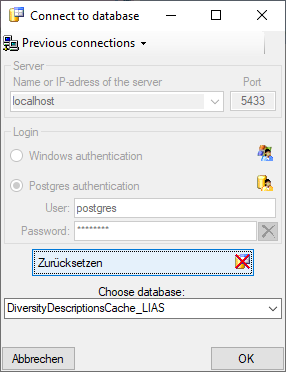 Postgres (Version 10 or above). To connect to a server, click on
the
Postgres (Version 10 or above). To connect to a server, click on
the

After entering valid login data to the Postgres server, at least the
 button will be available (see image below). Click on the
button will be available (see image below). Click on the
 button to create a new cache database (see below). You will be asked
for the name of the database and a short description.
button to create a new cache database (see below). You will be asked
for the name of the database and a short description.
After the database was created, you have to update the database to the current version. Click on the Update
 button to open a window listing all needed scripts. To run these scripts
just click on the Start update
button to open a window listing all needed scripts. To run these scripts
just click on the Start update
 button. After the update the database is ready to take your data. Subsequent
updates may become necessary with new versions of the database. To remove the current
database from the server, just click on the
button. After the update the database is ready to take your data. Subsequent
updates may become necessary with new versions of the database. To remove the current
database from the server, just click on the
 button.
button.In the image on the right you see a screenshot from the tool pgAdmin 4 . You may use this tool to inspect your data and administrate the database independent from DiversityDescriptions. Please keep in mind, that any changes you insert on this level may disable your database from being used by DiversityDescriptions as a sink for your cache data. The data are organized in
 schemas, with
schemas, with
 public as the default schema. Here you find
public as the default schema. Here you find
 functions for marking the database as a module of the Diversity Workbench and the
version of the database. The tables in this schema are e.g.
functions for marking the database as a module of the Diversity Workbench and the
version of the database. The tables in this schema are e.g.
 TaxonSynonymy where the data derived from DiversityTaxonNames are stored and
TaxonSynonymy where the data derived from DiversityTaxonNames are stored and
 ReferenceTitle where the data derived from DiversityReferences are stored. For every
project a separate schema is created (here
ReferenceTitle where the data derived from DiversityReferences are stored. For every
project a separate schema is created (here
 Project_LIASlight). The project schemas contain 2
Project_LIASlight). The project schemas contain 2
 functions for the ID of the project and the version. The data are stored in the
functions for the ID of the project and the version. The data are stored in the
 tables while the packages in their greater
part are realized as
tables while the packages in their greater
part are realized as
 views and
views and
 functions extracting and converting the data from the tables according to their
requirements.
functions extracting and converting the data from the tables according to their
requirements.
If you connect to a Postgres database for the very first time, you must use an account with sufficient rights to create databases, e.g. "postgres". After performing the first database update the role "CacheAdmin" is available, which has sufficient rights for any cache database operation. To create new logins and grant access to the Postgres cache database for other users, see chapter Login administration of the cache databases .
